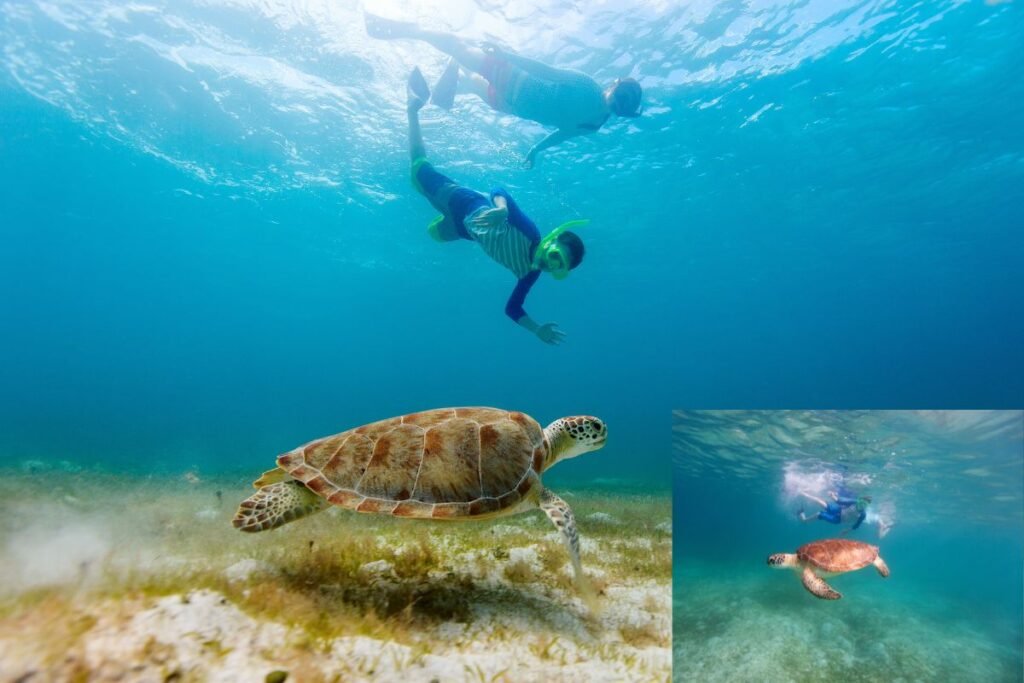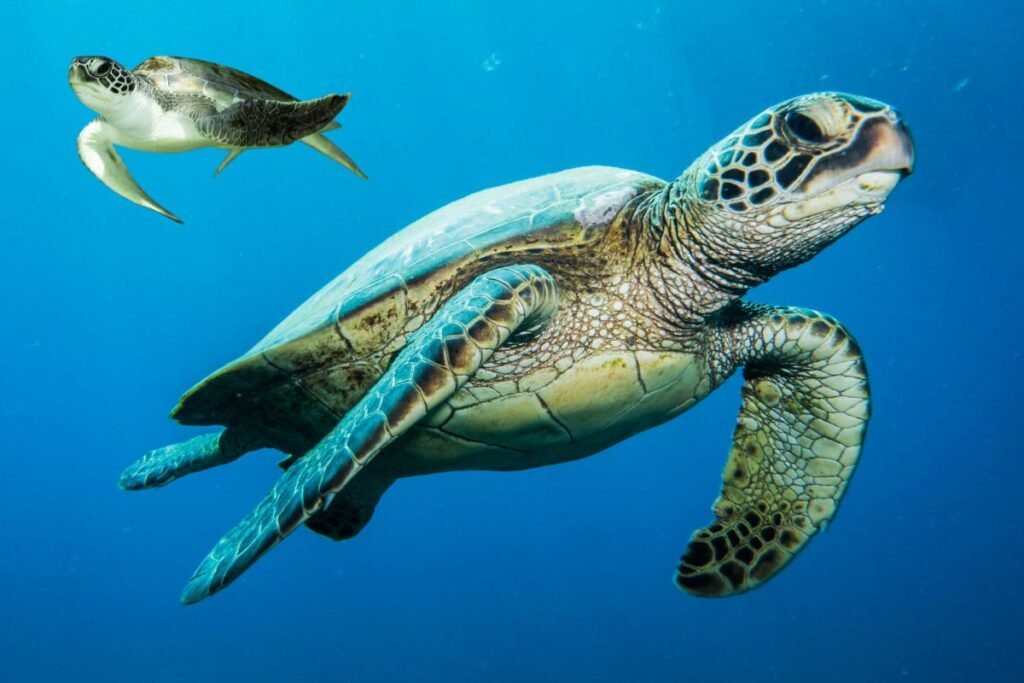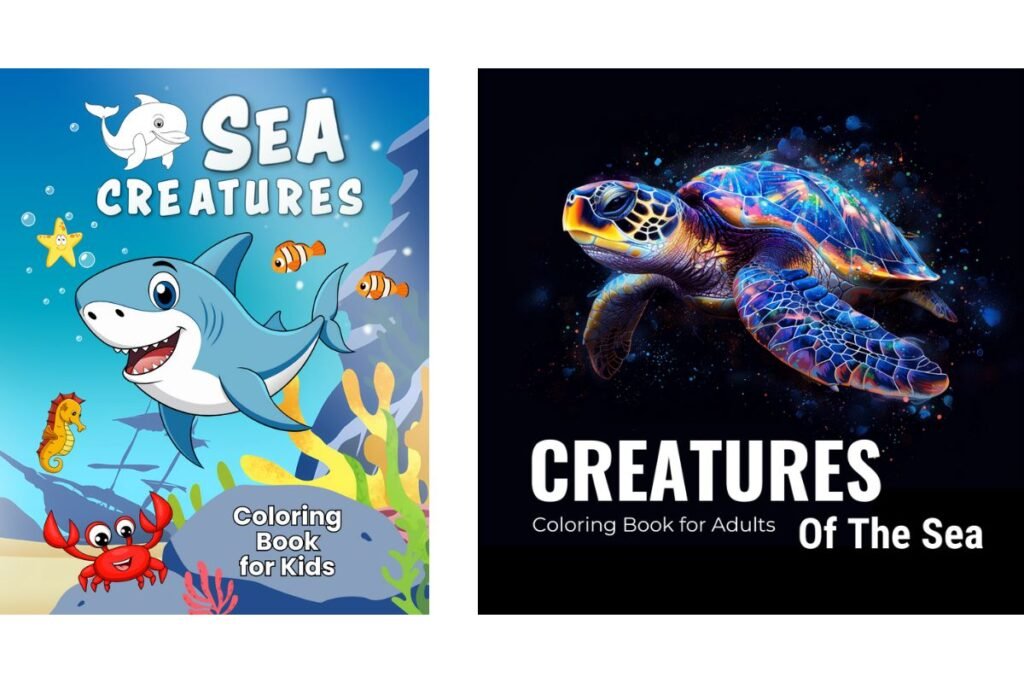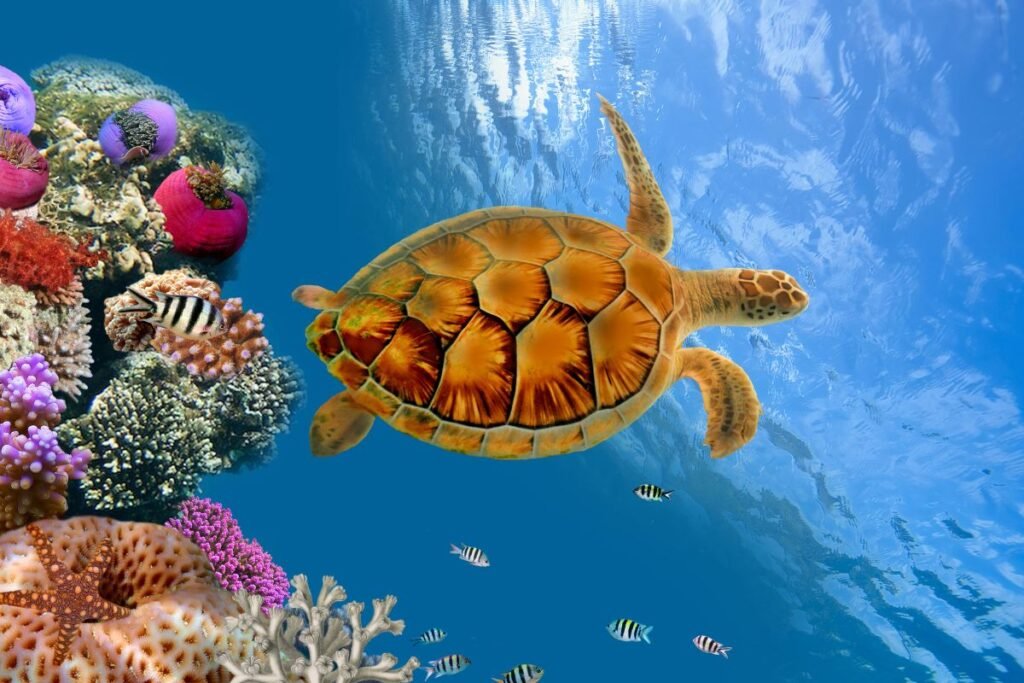Table of Contents
ToggleSea turtles, ancient mariners of the ocean, captivate us with their graceful movements and intriguing life stories.
These remarkable reptiles have roamed the Earth’s oceans for over 100 million years, coexisting with dinosaurs and surviving mass extinctions. In this comprehensive guide, we’ll dive into the fascinating world of sea turtles, exploring their species, lifespan, diet, habitats, and the pressing issue of their endangered status. Additionally, we’ll answer some commonly asked questions about these enchanting creatures.
What are 5 Interesting Facts About Sea Turtles?
1. Longevity: Sea turtles are among the longest-living creatures on Earth, with some species living for over 100 years. This extraordinary lifespan is a testament to their resilience and adaptability in the wild.
2. Migration: Sea turtles are known for their impressive migratory journeys. Some species, like the leatherback turtle, travel thousands of miles across oceans, from feeding grounds to nesting sites.
3. Gender Determination: The temperature of the sand where eggs are incubated determines the sex of hatchlings. Warmer sand produces females, while cooler sand produces males. This fascinating aspect of their reproduction is a unique adaptation among reptiles.
4. Breathing Underwater: While sea turtles are excellent swimmers, they still need to surface for air. They can hold their breath for several hours, depending on their activity level, but typically come up for air every 5 to 30 minutes.
5. Diet Variability: Sea turtles’ diets vary by species. For instance, green sea turtles primarily eat seagrass and algae, while loggerheads favor a diet of jellyfish, crabs, and mollusks. This dietary diversity helps maintain the health of marine ecosystems.
How Long Can a Sea Turtle Live?
Sea turtles can live for several decades, with some individuals reaching ages of 80 to 100 years or more. The exact lifespan of a sea turtle depends on the species, environmental conditions, and threats they face in the wild. For example, the leatherback turtle, the largest of all sea turtle species, can live for over 50 years. Meanwhile, green sea turtles are known to have lifespans that often exceed 80 years.
Can You Swim with Sea Turtles?
Swimming with sea turtles is a dream for many ocean enthusiasts. It is indeed possible to swim with these majestic creatures in certain locations around the world. Destinations like the Caribbean, Hawaii, and the Great Barrier Reef offer guided snorkeling and diving tours where you can observe sea turtles in their natural habitat.
However, it’s crucial to follow guidelines to ensure their safety and well-being:
– Maintain a respectful distance to avoid disturbing them.
– Do not touch or chase sea turtles.
– Use reef-safe sunscreen to protect their habitats from harmful chemicals.

How Old is the Oldest Sea Turtle?
The oldest known sea turtle was a remarkable specimen named Jonathan, believed to be around 200 years old. However, Jonathan is not a sea turtle but a Seychelles giant tortoise. In terms of sea turtles, while specific age records are challenging to verify due to the lack of long-term studies, some sea turtles are known to live well over 100 years, making them some of the longest-living vertebrates on Earth.
Why Are Sea Turtles Endangered?
Sea turtles face numerous threats that have led to their endangered status. These threats include:
– Habitat Loss: Coastal development and beach erosion reduce nesting sites.
– Pollution: Plastic waste, oil spills, and other pollutants can be fatal to sea turtles.
– Climate Change: Rising sea levels and temperature changes affect nesting sites and hatchling survival rates.
– Bycatch: Incidental capture in fishing gear is a significant threat.
– Illegal Trade: Poaching for their shells, meat, and eggs continues in some regions.
Sea Turtle Species
There are seven species of sea turtles, each with unique characteristics:
1. Leatherback Turtle (Dermochelys coriacea): The largest sea turtle, distinguished by its leathery shell.
2. Green Sea Turtle (Chelonia mydas): Named for the green fat beneath its shell, primarily herbivorous.
3. Loggerhead Turtle (Caretta caretta): Known for its large head and strong jaws.
4. Hawksbill Turtle (Eretmochelys imbricata): Recognizable by its pointed beak and patterned shell.
5. Olive Ridley Turtle (Lepidochelys olivacea): Smallest sea turtle, known for synchronized nesting in mass numbers.
6. Kemp’s Ridley Turtle (Lepidochelys kempii): Critically endangered, nests primarily on one beach in Mexico.
7. Flatback Turtle (Natator depressus): Limited to the coastal waters of Australia, named for its flat shell.

Where Are Sea Turtles Found?
Sea turtles inhabit tropical and subtropical oceans worldwide. Their distribution varies by species:
– Leatherback Turtles: Found in the Atlantic, Pacific, and Indian Oceans.
– Green Sea Turtles: Common in the Atlantic and Indo-Pacific regions.
– Loggerhead Turtles: Distributed across the Atlantic, Pacific, and Indian Oceans.
– Hawksbill Turtles: Primarily found in coral reefs of the Indo-Pacific.
– Olive Ridley Turtles: Inhabit the tropical regions of the Pacific and Indian Oceans.
– Kemp’s Ridley Turtles: Mainly found in the Gulf of Mexico and the Atlantic Ocean.
– Flatback Turtles: Endemic to the waters around Australia.
What Do Sea Turtles Eat?
The diet of sea turtles varies significantly by species:
– Leatherback Turtles: Primarily consume jellyfish, playing a crucial role in controlling jellyfish populations.
– Green Sea Turtles: Herbivores that feed on seagrass and algae, contributing to the health of seagrass beds.
– Loggerhead Turtles: Omnivorous, feeding on crustaceans, fish, and mollusks.
– Hawksbill Turtles: Mainly eat sponges, which helps maintain the health of coral reefs.
– Olive Ridley Turtles: Omnivorous, consuming a variety of prey including algae, lobster, and fish.
– Kemp’s Ridley Turtles: Primarily eat crabs and other crustaceans.
– Flatback Turtles: Feed on sea cucumbers, jellyfish, and mollusks.
How Many Sea Turtles Are Left?
Estimating the exact number of sea turtles left in the wild is challenging due to their widespread distribution and migratory nature. However, all seven species of sea turtles are classified as threatened or endangered, with varying population sizes. Conservation efforts are crucial to protect these magnificent creatures and their habitats. Some estimates suggest there are around 1 million nesting females left across all species, but this number is continually changing due to conservation successes and ongoing threats.
Interesting Facts About Sea Turtles
– Ancient Lineage: Sea turtles have existed for over 100 million years, making them older than many dinosaur species.
– Navigation Skills: Sea turtles have an incredible ability to navigate back to the exact beach where they were born to lay their eggs.
– Strong Swimmers: They can swim at speeds of up to 35 km/h (22 mph) when necessary.
– Adaptability: Despite their ancient lineage, sea turtles have adapted to a variety of marine environments, from warm tropical waters to cooler temperate seas.
– Vital Role in Ecosystems: Sea turtles play crucial roles in marine ecosystems, from maintaining healthy seagrass beds and coral reefs to controlling jellyfish populations.
Sea Turtles’ Scientific Names
Here are the scientific names of the seven sea turtle species:
1. Leatherback Turtle: Dermochelys coriacea
2. Green Sea Turtle: Chelonia mydas
3. Loggerhead Turtle: Caretta caretta
4. Hawksbill Turtle: Eretmochelys imbricata
5. Olive Ridley Turtle: Lepidochelys olivacea
6. Kemp’s Ridley Turtle: Lepidochelys kempii
7. Flatback Turtle: Natator depressus
Conclusion
Sea turtles are truly remarkable creatures that have captured the fascination of people worldwide. Their long lifespans, extensive migrations, and vital roles in marine ecosystems highlight their importance and the need for continued conservation efforts.
By understanding the challenges they face and supporting initiatives to protect their habitats, we can help ensure that sea turtles continue to grace our oceans for generations to come.
Whether you’re interested in swimming with them, learning about their diets, or discovering their ancient lineage, sea turtles offer endless opportunities for exploration and admiration.
Learn more and get involved in sea turtle conservation today! And if you’re looking for a relaxing and creative way to engage with the beauty of the ocean, check out my coloring book for adults featuring stunning sea creatures. Dive into a world of color and support ocean conservation with every stroke of your pencil! 🌊🐢


